Goyt Mill at Hawk Green was the last cotton mill to be built in the Marple area, and is the only building of that kind left standing locally today. Set on rising ground on the east bank of the Macclesfield Canal just after Hibbert Lane crosses the canal on Eccles Bridge (Bridge 3), it can be seen from near and far. Once the steam engine was sufficiently developed to provide a reliable source of power for turning machinery, mills no longer had to rely on fast flowing streams to turn water wheels, and canal banks made attractive sites for cotton mills because the canal could be used to transport raw materials and finished goods, and to provide water for the boilers.
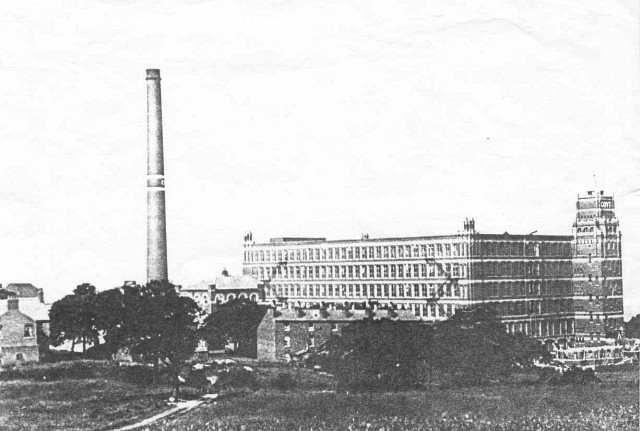
Goyt Mill dominates
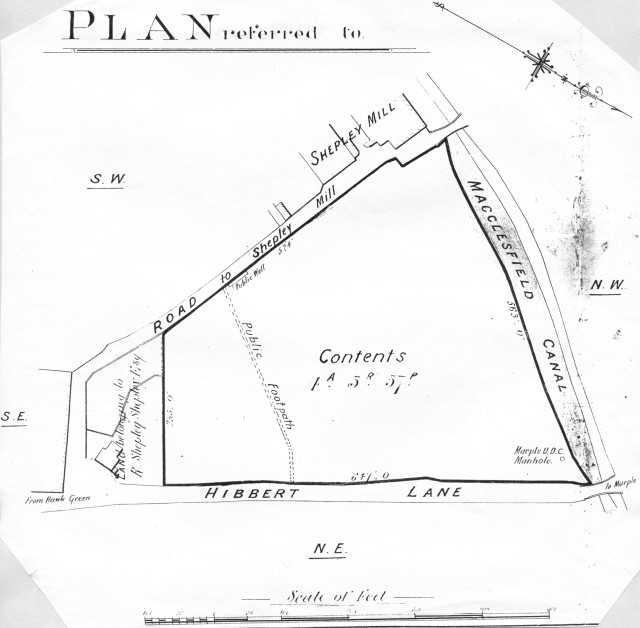 A miscellaneous group of businessmen made up the first Board of Directors of the ‘Goyt Mill Spinning Company Ltd.’ under the Chairmanship of William Pearson of Eccles. The other directors were Thomas Hill Lees, a hat manufacturer of Stockport, Joseph Schofield, grocer of Patricroft, George Pollitt, fruit merchant of Stockport, John J.M. Dowzer, doctor of Eccles, John T. Ogden, merchant of Manchester, and Owen Gregory, gentleman of Ashton on Mersey. They bought a plot of land of 4 acres, 3 roods and 37 perches for £996.5s.0d. from Robert Shepley Shepley the owner of the adjacent Shepley Mill, alias Rhode House/Ridge/Marple Mill.
A miscellaneous group of businessmen made up the first Board of Directors of the ‘Goyt Mill Spinning Company Ltd.’ under the Chairmanship of William Pearson of Eccles. The other directors were Thomas Hill Lees, a hat manufacturer of Stockport, Joseph Schofield, grocer of Patricroft, George Pollitt, fruit merchant of Stockport, John J.M. Dowzer, doctor of Eccles, John T. Ogden, merchant of Manchester, and Owen Gregory, gentleman of Ashton on Mersey. They bought a plot of land of 4 acres, 3 roods and 37 perches for £996.5s.0d. from Robert Shepley Shepley the owner of the adjacent Shepley Mill, alias Rhode House/Ridge/Marple Mill.
Shepley Mill had been built in the 1830s, fairly soon after the Macclesfield Canal opened, as a steam-powered cotton spinning and weaving mill, to make use of the attributes of the canal. It stood a little further south than Goyt Mill, again on the east bank of the canal, where Wright Hire have their premises today, and was accessed from Shepley Lane. Shepley Mill functioned for some time after Goyt Mill came into operation, but a serious fire demolished the warehouse in 1926 and the loss was not covered by insurance. The business never quite recovered and had closed by 1930, with the buildings demolished in the early 1930s, sadly leaving no illustrations to tell us what it looked like.
The first sod for Goyt Mill was cut with due ceremony, on July 20th 1905, (see invitation) and building commenced straight away to the design of Stott and Company, a pre-eminent firm of architects specialising in Lancashire cotton mills. (see artists impression) It has the typical ‘chunky’ rectangular style of an Edwardian steam-powered cotton mill, six storeys high, built of reinforced concrete and clad in red engineering brick with yellow brick decoration. The internal structure of the mill consisted of ten rows of cast iron pillars, eight in a row, with flanged castings at the top supporting H section steel beams running lengthways. The pillars formed bays 20 feet by 15 feet and the rooms on each floor were 250 feet x 150 feet. Mills of this era could be much wider and bigger than earlier water-powered mills, because the introduction of effective gas lighting did away with the need to have all the machinery near the windows to make maximum use of natural daylight. In addition the steam engine delivered more power than a water wheel, enabling increased output and thus potentially more profit.

By the time that Goyt Mill became operational, many mills were equipped to both spin yarn and weave cloth, but this mill was set up only for spinning and the yarn was sent elsewhere for weaving. Trade adverts (see advert) tell us that they dealt with American, Egyptian and East African cotton plus a little high quality Russian cotton, and that ‘Goyt Yarns’ were in demand for weaving into all kinds of products by manufacturers from all over the country.Coal came from Staffordshire along the Macclesfield Canal, and both raw cotton and the finished spun yarn were also transported by canal. It took several years from building until operating at full capacity, but by then there were 480 cotton operatives and an office staff of 12.
The mill opened as a mule spinning mill with 82,000 mule spindles on 30 pairs of mules in 3 rooms plus a few ring spindles, but by 1934 they had changed mostly to ring spindles. Ring spinning was an American development which produced more yarn per hour than a mule but at the cost of treating the raw cotton more harshly, necessitating the use of a better grade of cotton fibre. Over the years the technology improved and by 1900 ring spinning exceeded mule spinning. However, the Lancashire mills were slow to adopt the new methods and took their time, as illustrated by Goyt Mill.
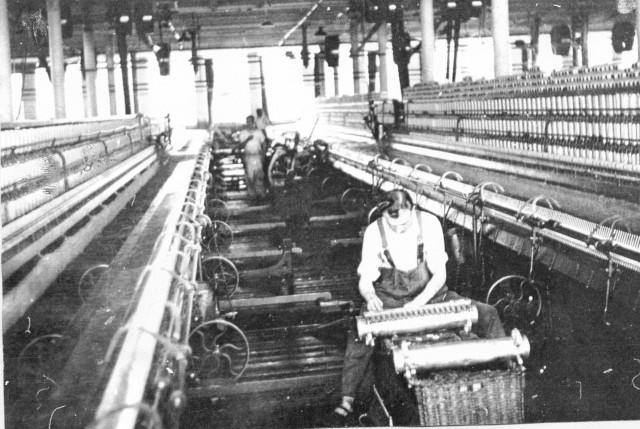
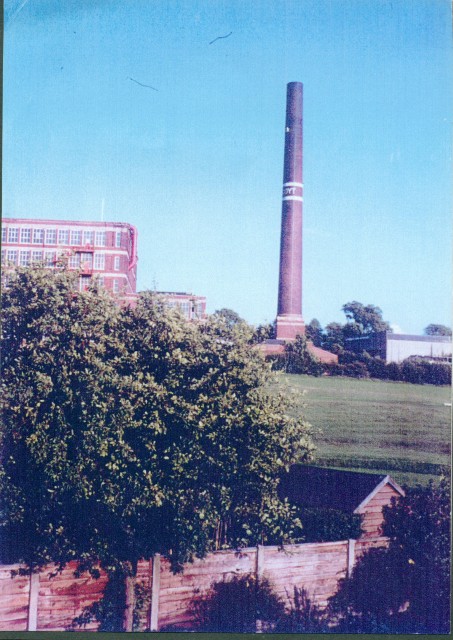 The ground floor was devoted to the preparation and winding machinery, with carding engines on the first floor, drawing and roving frames above that and spinning machinery on the upper floors. The offices, surmounted by the water tower, were at the northern corner of the building fronting on to Hibbert Lane, and the windows were etched with the name of ‘Goyt Mill Spinning Company Ltd’. The engine house was at the other (south) end with the boiler house which contained five Lancashire boilers as well as a ‘Greens economiser’, a design to increase the steam raising efficiency of a stationary steam engine. A Mather and Platt pump was used to raise water from the canal in a 10” pipe, with waste warm water returned to the canal through a 12” pipe. Local legend has it that this warmed up the canal sufficiently to make it attractive for swimming! The mill was powered by a horizontal, double expansion, compound steam engine delivering 2500hp, built by Carel Frères of Ghent in Belgium. It drove a large drum or ‘rope race’ round which were wrapped long cotton ropes transmitting the power to line shafting on each floor and thence to individual machines by belt drives.
The ground floor was devoted to the preparation and winding machinery, with carding engines on the first floor, drawing and roving frames above that and spinning machinery on the upper floors. The offices, surmounted by the water tower, were at the northern corner of the building fronting on to Hibbert Lane, and the windows were etched with the name of ‘Goyt Mill Spinning Company Ltd’. The engine house was at the other (south) end with the boiler house which contained five Lancashire boilers as well as a ‘Greens economiser’, a design to increase the steam raising efficiency of a stationary steam engine. A Mather and Platt pump was used to raise water from the canal in a 10” pipe, with waste warm water returned to the canal through a 12” pipe. Local legend has it that this warmed up the canal sufficiently to make it attractive for swimming! The mill was powered by a horizontal, double expansion, compound steam engine delivering 2500hp, built by Carel Frères of Ghent in Belgium. It drove a large drum or ‘rope race’ round which were wrapped long cotton ropes transmitting the power to line shafting on each floor and thence to individual machines by belt drives.
The tall, circular section, brick chimney, set on a square brick plinth, was next to the Engine House. The name ‘Goyt’ was picked out in white tiles high up and it could be seen from miles around until 1986 when it had to be demolished, as it was unsafe. This is no exaggeration; there was a long crack in the structure and it was swaying in the breeze!
The demolition technique was interesting. A scaffold on rollers was positioned around the top of the chimney, and a hole knocked in the square plinth. (the Hole) The bricks were knocked down inside the chimney and removed from the hole. Meanwhile the scaffolding rolled down the outside of the chimney. The series of photos below show the process.
Before the Industrial Revolution Hawk Green had been a hill farming area with a low population. When Mr Robert Shepley built his mill on the banks of the canal in the 1830s, his workers were in need of housing and he addressed the problem by providing two terraces of workers’ cottages accessed from Barnsfold Road and a 3 sided complex at Rhode Houses (see image) on Upper Hibbert Lane. Goyt Mill had nearly 500 employees and was a major local business, attracting many people into the area looking for work. Edwardian style terraced houses of red Accrington brick were built at the beginning of Barnsfold Road, in Upper Hibbert Lane, and on The Green, marked out by their imposing lintels, bay windows and smart stone gateposts, often with house names which must have been chosen by the first occupants.
Increasing population demanded social and commercial facilities. A branch of the Compstall Industrial Cooperative Society had opened in 1882 in a building at the corner of Barnsfold Road, (left), providing for everyone’s household needs, and they already had The Crown (see image) which had started as a farm with beerhouse and had risen in status to be called an inn, but there was little other social provision. The Reading Room, of which the foundation stones were laid in 1906, was built by public subscription to fill this gap, but was aimed primarily at Goyt Mill employees in the first instance. (see Our Local Heritage article for April 2020).
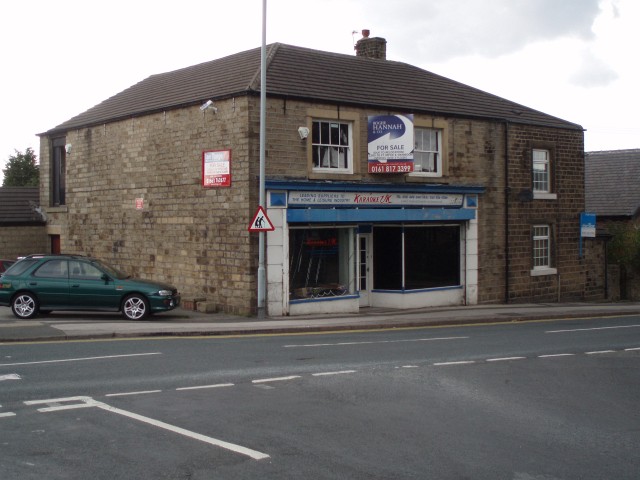
After the Second World War the British cotton industry declined rapidly and yarn production stopped at this mill in 1960. The building was sold to Sterling Moulded Materials Ltd., of Stalybridge and after standing empty for a few years it was rented to Kay Metzeler Ltd., who used it for the manufacture of plastic foams until 1981. After another period of ‘vacancy’, units are now rented out for many different purposes. Over the years this has included a restaurant and snooker hall, children’s soft play gym, fitness centre, bamboo furniture showroom, furniture restorer, a printer, gas fitter, farrier, artist’s studio, among others. The offices are occupied by a company supplying feed and other horse supplies, and the engine house at the other end of the complex has for many years been fitted out as an indoor climbing wall called ‘Rope Race’ in tribute to its origins, though they do hold climbing competitions (rope races) there nowadays. Mill engine houses lend themselves well to this use because they are strongly built and very tall. Rope Race is one of the highest in the country with routes up to about 60’ long.

Goyt Mill had a life of less than sixty years in the cotton industry for which it was built, but still provides all sorts of useful functions today. Even if you don’t want to go indoor climbing, haven’t a horse, don’t need the services of a printer or to buy some furniture, you might still appreciate the value of this landmark to remind you of home territory when looking towards Marple from afar.






